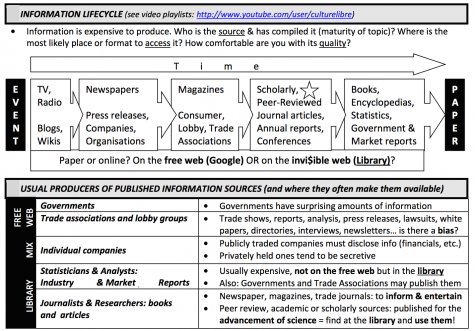Critical Thinking Publishing Reference
What are primary sources in business?
Olivier Charbonneau 2020-10-07
According to the Concordia University Library website:
A primary source is any original work that is unmediated by external analysis, evaluation, or interpretation. A secondary source is typically an external study of primary sources, usually written retrospectively. A tertiary source typically amalgamates the content found in primary and secondary sources and is less critical or argumentative than secondary sources.
Source: Concordia University Library, What are primary sources?
With regards to primary or secondary sources, the distinction usually about the identity of the organization issuing the source. In the field of business, primary sources are documents issued by the corporation (press releases, product catalogues, corporate websites, advertisements, financial statements and other filings, etc.) while secondary sources are issued by others, most notably journalists or researchers writing articles about the corporation.
Interviews throw an interesting curve ball into this distinction. I would say that a news or trade journal article featuring an in-depth interview with an executive would probably qualify for a primary source, if the article contains only the interview. If the article only has a few quotes from a company source but contains much more than just the interview (say, commentary or analysis), then the article in question ceases to qualify as a primary source (primary = from the mouth of the corporation or their executives).
It is important to note that certain academic disciplines may have a different definition for primary/secondary sources. Most notably, historians usually consider historical newspaper articles as “primary sources” in their disciplines because of how they conceptualize these sources within the framework of their academic discipline. This is important should you seek out information on the Internet about primary/secondary sources…
Guidelines - recommendations Information literacy Publishing
Articles for business & academic insight
Olivier Charbonneau 2019-01-21
This post contains the lecture notes I will be using in an honors level undergraduate class. Remember, the library offers a Business Research Portal.
1. Is there information on the Internet?
- Lecture; 10 minutes
- Synthesis: Information (or more precisely: facts, opinions and data) is contained in documents. Documents may be posted on the Internet or published in electronic or print venues accessible through subscriptions or other forms of payment. A successful search for information implies thinking about (1) the motivations of those creating documents (e.g.: the goal) and their (2) expectations about posting on the internet or publishing in paid-for venues (e.g.: the source).

2. Compare articles
- Activity; 10 minutes; Compare articles from various sources: blog, magazine, trade journal, Wikipedia, subject encyclopedia and scholarly journal
Paper copies: magazines and scholarly journals
Wikipedia (Entry for International business) vs. International Encyclopedia of the Social & Behavioral Sciences (entry for International Business)
Blog (The benefits of online gambling) vs. Research Article (Video Lottery is the Most Harmful Form of Gambling in Canada)
- Focus: distinction between free or invisible (library) web
- Synthesis: all articles are not created for the same audiences. Academic or peer-reviewed articles are the standard way to publish research results. University students are groomed to craft academic articles through writing papers as part of the requirements for their classes
3. Academic articles: structure and editorial process of scholarly communication
- Lecture; 10 minutes
- Synthesis: Structure & Editorial process of scholarly communication.
- Structure of an academic article: research questions; conceptual framework; hypothesis/objectives and method; data & analysis; conclusion (very similar to an academic paper)
- Process: peer review
4. Tools & strategies
- Activity: 20 minutes
- Transforming concepts to keywords for database searching
- Compare Google Scholar and a library article database
- Working from a known item – read the bibliography and explore related articles. Locate the article in a database and obtain keywords
- Data sources on the Internet – be mindful of secrets
5. Outputs
Annotated bibliography: 5 minutes
Academic paper: 5 minutes
Using MS Word(tm) with style
Citing business databases in APA format
Automated citation system: RefWorks or Zotero
6. Questions and discussion
Academic Integrity Publishing Universities
Poland want to make plagiarism illegal
Olivier Charbonneau 2014-08-07
A note from the IP Watch service indicates that Poland’s parliament is considering a bill to require that higher education institutions use plagiarism detection software in theses.
Assessment Publishing Research
Altmetrics in Context
Olivier Charbonneau 2014-01-12
The Canadian Association of Research Libraries (CARL) has published a useful guide to altmetrics (pdf). Altmetrics are alternative metrics to measure the impact of research.
Also of interest, the Summer 2013 (vol. 25 issue 2) issue of Information Standards Quarterly from NISO covers altmetrics (direct link to the PDF of the full issue).
In the same vein, one can determine the impact of an institutional repository by visiting this page ranking repositories. The link send you to the Canadian listing, where my home institution’s Soectrum ranks fifth. In fact, I just learnt that I’m still in the top 10 researchers being downloaded from my University’s Institutional repository!
